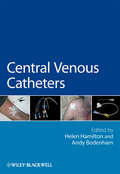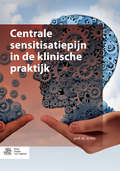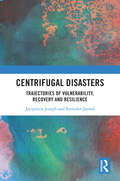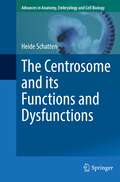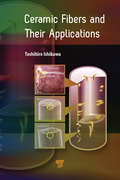- Table View
- List View
Central Neural Mechanisms in Cardiovascular Regulation: Volume 2
by KUNOS CIRIELLOHigh blood pressure disease is one of the most prevalent pathological conditions in modem society with potentially serious consequences. During the last two decades major progress has been made in the development of rational approaches to the treatment of high blood pressure. A key factor in this progress has been an increase in our understanding of how the brain controls blood pressure. The chapters in the present book, together with those in a previous volume, provide a broad overview of recent progress in our knowledge of the central neural mechanisms involved in the regulation of the cardiovascular system. It is our hope that these essays by leading experts in the field will not only provide a useful source of information, but will also stimulate inquiry leading to new discoveries in this critically important field of research. George Kunos John Ciriello vii List of Contributors Jeffrey J. Anderson, Department of Pharmacology and Toxicology, Indiana University School of Medicine, Indianapolis, Indiana 46208, USA Katsuyuki Ando, Fourth Department of Internal Medicine, University of Tokyo School of Medicine, Tokyo 112, Japan Jaideep S. Bains, Department of Physiology, Queen's University, Kingston, Ontario, Canada K7L 3N6 Kathleen H. Berecek, Department of Physiology and Biophysics and the Vascular Biology and Hypertension Program, The University of Alabama at Birmingham, Birmingham, Alabama 35294, USA Vernon S. Bishop, Department of Physiology, The University of Texas Health Science Center, San Antonio, Texas 78284-7756, USA P. A.
Central Neurone Environment and the Control Systems of Breathing and Circulation (Proceedings in Life Sciences)
by M. E. Schläfke H. P. Koepchen W. SeeThis volume contains the papers presented at the symposion on Central Neurone Environment and the Control Systems of Breathing and Circulation held at Bochum, October 5-7,1981 in honour of Prof. Dr. Dr. h.c. Hans H. Loeschcke, who retired in March 1981. His discovery of ventral medullary substrates forming an essential drive for the ventilatory as well as for circulatory control systems, and the elaboration of this concept during the last 25 years have profoundly influenced the concepts in this field. In an age of proceeding specializa tion on partial mechanisms, his approach has always emphasized the integrative aspects of the control systems, especially the role of the respiratory control system for the ionic homeostasis of the brain and the close interrelation between neuronal respiratory and cardiovascular control. This general intention implies the combination of physico chemical and neurophysiological approaches as well as the study of peripheral function of respiration and circulation, topics which are usually handled separately according to the different methods.
Central Pain Syndrome
by Sergio Canavero Vincenzo BonicalziThis book sheds new light on central pain, a field that is largely obscured by lack of knowledge among pain professionals at all levels, including high-end pain centers. As a matter of fact, central pain, classified as a form of neuropathic pain, remains too often a scourge for those affected due to the ignorance of pain therapists worldwide and enduring misconceptions at the academic level. By weighing up the relevant evidence, the authors aim to remedy the situation by providing clear-cut, no-nonsense, unbiased and directly applicable clinical information. The clinically sound guidelines presented here are based on the authors’ twenty years of treating patients and conducting research in the field. The book will be an invaluable guide for neurologists, neurosurgeons, anesthesiologists, pain therapists as well as physiotherapists.
Central Processing of Visual Information A: Integrative Functions and Comparative Data (Handbook of Sensory Physiology #7 / 3 / 3 A)
by H. Autrum P. O. Bishop V. Braitenberg K. L. Chow R. L. Valois R. B. Freeman W. A. Grind O.-J. Grüsser U. Grüsser-Cornehls R. Jung W. R. Levick H.-U. Lunkenheimer D. M. MacKay M. Snyder J. Stone N. J. Strausfeld I. ThomasThe present volume covers the physiology of the visual system beyond the optic nerve. It is a continuation of the two preceding parts on the photochemistry and the physiology of the eye, and forms a bridge from them to the fourth part on visual psychophysics. These fields have all developed as independent speciali ties and need integrating with each other. The processing of visual information in the brain cannot be understood without some knowledge of the preceding mechanisms in the photoreceptor organs. There are two fundamental reasons, ontogenetic and functional, why this is so: 1) the retina of the vertebrate eye has developed from a specialized part of the brain; 2) in processing their data the eyes follow physiological principles similar to the visual brain centres. Peripheral and central functions should also be discussed in context with their final synthesis in subjective experience, i. e. visual perception. Microphysiology and ultramicroscopy have brought new insights into the neuronal basis of vision. These investigations began in the periphery: HARTLINE'S pioneering experiments on single visual elements of Limulus in 1932 started a successful period of neuronal recordings which ascended from the retina to the highest centres in the visual brain. In the last two decades modern electron microscopic techniques and photochemical investigations of single photoreceptors further contributed to vision research.
Central Regulation of Autonomic Functions
by Ida J. Llewellyn-Smith Anthony J. M. VerberneCentral autonomic circuits in the brain and spinal cord are essential to vertebrate life because they are involved in controlling all basic bodily functions, including blood pressure, feeding, body temperature regulation voiding and reproduction. This wide-ranging text emphasizes the extraordinary advances that have been made over the last 20 years in understanding how the central nervous system controls autonomic functions.
Central Regulation of Energy Metabolism With Special Reference To Circadian Rhythm
by Katsuya NagaiThis excellent book describes the roles of the suprachiasmatic nucleus (SCN) of the hypothalamus as a regulatory center of homeostatic mechanism and a circadian oscillator in mammals, including humans. The authors emphasize two important points based on their findings: 1) SCN plays a critical role in central regulation of energy metabolism through which a constant supply of glucose to the central nervous system (CNS) is well maintained; and 2) neurons responsible for the regulation of energy metabolism are located in the ventrolateral part of the SCN and receive retinal neural inputs through both the retinohypothalamic tract and the geniculohypothalamic tract. The authors then discuss the evolutionary importance of these points to the survival of mammals on earth. Other topics examined include the involvement of light in the regulation of neural activity of the autonomic nervous system through the retina and SCN, in addition to the relation of the SCN with regulations of other autonomic nerve functions, such as blood pressure and body temperature. Central Regulation of Energy Metabolism with Special Reference to Circadian Rhythm is important reading for researchers and students in neuroendocrinologists, neurobiologists, biochemists, endocrinologists, physiologists, chronobiologists, psychologists, pharmacologists, and others interested in the topic.
Central Regulation of Energy Metabolism With Special Reference To Circadian Rhythm
by Katsuya NagaiThis excellent book describes the roles of the suprachiasmatic nucleus (SCN) of the hypothalamus as a regulatory center of homeostatic mechanism and a circadian oscillator in mammals, including humans. The authors emphasize two important points based on their findings: 1) SCN plays a critical role in central regulation of energy metabolism through which a constant supply of glucose to the central nervous system (CNS) is well maintained; and 2) neurons responsible for the regulation of energy metabolism are located in the ventrolateral part of the SCN and receive retinal neural inputs through both the retinohypothalamic tract and the geniculohypothalamic tract. The authors then discuss the evolutionary importance of these points to the survival of mammals on earth. Other topics examined include the involvement of light in the regulation of neural activity of the autonomic nervous system through the retina and SCN, in addition to the relation of the SCN with regulations of other autonomic nerve functions, such as blood pressure and body temperature. Central Regulation of Energy Metabolism with Special Reference to Circadian Rhythm is important reading for researchers and students in neuroendocrinologists, neurobiologists, biochemists, endocrinologists, physiologists, chronobiologists, psychologists, pharmacologists, and others interested in the topic.
Central Regulation of the Endocrine System (Nobel Foundation Symposia #42)
by K. FuxeAccording to the classical concept of Geoffrey Harris the pituitary gland is controlled by the brain by means of blood-borne chemical messengers produced by central neurons. The recent isolation and structural characterization of several such messengers by Roger Guillemin and Andrew Schally and their collaborators brought the final proof for this hypothesis. This also meant that the extensive knowledge collected in the field of neurobiology now became highly relevant for the endocrinologists. For this reason it was felt important to organize a symposium which brought together experts in the fields of neurobiology and endocrinology. The idea was to focus the attention on neuronal mechanisms, particularly those related to chemical transmission, which may be of importance for the central regulation of hormonal secretion patterns. We would like to express our sincere gratitude to the Nobel Founda tion for supporting the organization of the Nobel Symposium 42 on "Principles of the Central Regulation of the Endocrine System". We would also like to express our thanks to all participants, to Professor Carl-Gustaf Bernhard, Permanent Secretary of the Royal Academy of Sciences, for making the facilities of the Academ- available to us, and to the Symposium secretaries Mrs. Gun Hultgren, Mrs. Lena Persson and Mrs. Ulla-Britt Wedin. It is a pleasure to acknowledge the generous financial support from the Nobel Foundation and its Nobel Symposium Committee through grants from the Tercentenary Foundation of the Bank of Sweden, and from the Swedish Medical Research Council, KABI AB, Stockholm, and ASTRA AB, Sodertalje.
Central Regulation of the Pituitary-Adrenal Complex (Studies in Soviet Science)
by E. V. NaumenkoThis monograph gives an up-to-date account of the original results of the author's research in the complex field of the central control over relationships which have become established in the course of evolution between the hypothalamus and the pituitary gland. The author has limited the scope of this research on logical grounds to the study of central chemically reactive structures in the regulation of the adrenal glands through the intermediary of the hypothalamo-hypophyseal system. Through the author's skill and expertise in the analysis of the extensive and sometimes complicated literature he has successfully undertaken a differential approach to the analysis of the concrete role of catecholamines, acetylcholine, and serotonin in relation to the endocrine system. The vast range of experimental investigations and results of clinical observations published in the last few decades have revealed the humoral neurosecretory factors of the hypothalamus as impor tant regulators of the princ ipal functions of the pituitary gland and, through it, of the cyclic activity of the peripheral group of endocrine glands. Until recently the region of the cascade of regulatory in fluences preceding the hypothalamus was terra incognita. It is for this reason that Evgenii Vladimirovich Naumenko's monograph ac quires its special importance for the neurophysiologist, for its author has striven, by the use of experimental methods, to ascertain in detail the nature of influences which for a long time were in terpreted as the general dogmas of an abstract "nervism.
Central Serous Chorioretinopathy
by Jay ChhablaniCentral Serous Chorioretinopathy discusses the mechanisms, pathogenesis and risk factors of CSCR, findings on various imaging modalities, available treatment options, and translational research into new treatment options for CSCR management. This comprehensive book is written for retina specialists and surgeons, researchers and clinical practitioners in sensory systems (vision), and ophthalmologists. Central Serous Chorioretinopathy (CSCR) is a common disorder across the world with a variable prognosis without any standard of care. Recently, advancements in imaging have led to a better understanding of the pathogenesis and mechanisms of this disease. Summarizes the clinical understanding of CSCRExplores pathogenesis, molecular mechanisms and risk factorsCompares angiography, tomography and additional imaging modalitiesIdentifies the best treatment practicesDiscusses new laser, photodynamic and oral medication treatments, along with translational research into potential new treatments
Central Venous Catheters (Wiley Series in Nursing #24)
by Andy BodenhamThis book addresses all the issues a patient may experience prior to receiving a VAD. Selection of equipment, practical aspects of technique, the pros and cons of the various veins, and modifications of technique for certain circumstances are examined. Covereage also includes the roles played by radiologists, anaesthetists, surgeons, nurses, and other team memebers. Throughout the chapters a reference is made to the IV Therapy Standards published by the Royal College of Nursing IV Therapy Forum in 2003. Each chapter is evidence based and fully referenced.
Centrale sensitisatiepijn in de klinische praktijk
by Jo NijsBij (para)medische professionals groeit het besef dat de pijnneurowetenschappen een belangrijke rol spelen in de praktijk van het (para)medisch handelen. Dit handige boek speelt in op de groeiende vraag naar verdieping over de implementatie van pijnneurowetenschappen in het klinisch handelen. Het geeft een praktische handleiding voor het klinisch herkennen en behandelen van patiënten met centrale sensitisatiepijn. Welke behandelvaardigheden heeft de (para)medische professional nodig om patiënten met centrale sensitisatiepijn te begeleiden? Wat is de plaats van farmacotherapie, pijneducatie, cognitieve gedragstherapie en oefentherapie in de behandeling van centrale sensitisatie? Het concept centrale sensitisatie wordt toegelicht aan de hand van casussen uit de klinische praktijk: pijn bij kanker, nekpijn en lage rugpijn. Centrale sensitisatiepijn in de klinische praktijk is relevant voor alle (para)medisch disciplines die met chronische pijn patiënten werken, zoals fysiotherapeuten, manueel therapeuten, oefentherapeuten en revalidatieartsen.
Centrifugal Disasters: Trajectories of Vulnerability, Recovery and Resilience
by Jacquleen Joseph Surinder JaswalThis book focuses on centrifugal disasters that impact a group of seemingly unconnected people congregated temporarily often by chance, unlike centripetal disasters that strike an extant community of people. In India as well as in South Asia, centrifugal disasters have increased significantly in the last few decades, however the research remains limited as they are often categorized as accidents. The book documents three such major disaster events––26/11 terror attacks and 13/7 blasts in Mumbai, and hospital fire in Kolkata–– and analyses the lived and felt experiences of the survivors and their families. Drawing on the authors’ experience of working with survivors, first responders (police, health workers), as well as policy makers, the book suggests a model of disaster intervention that bridges academia and praxis expertise. Besides providing a rights framework for disaster interventions, it also explores the moral and ethical considerations around disaster interventions. This important book will be of interest to students and practitioners of disaster management including first responders and those working in public management, risk management, hazards and disasters, emergency response, terrorism and political violence. It will also be useful to mental health professionals, social workers, psychologists, civil society organizations, as well as bureaucrats and policy makers.
Centrifugal Disasters: Trajectories of Vulnerability, Recovery and Resilience
by Jacquleen Joseph Surinder JaswalThis book focuses on centrifugal disasters that impact a group of seemingly unconnected people congregated temporarily often by chance, unlike centripetal disasters that strike an extant community of people. In India as well as in South Asia, centrifugal disasters have increased significantly in the last few decades, however the research remains limited as they are often categorized as accidents. The book documents three such major disaster events––26/11 terror attacks and 13/7 blasts in Mumbai, and hospital fire in Kolkata–– and analyses the lived and felt experiences of the survivors and their families. Drawing on the authors’ experience of working with survivors, first responders (police, health workers), as well as policy makers, the book suggests a model of disaster intervention that bridges academia and praxis expertise. Besides providing a rights framework for disaster interventions, it also explores the moral and ethical considerations around disaster interventions. This important book will be of interest to students and practitioners of disaster management including first responders and those working in public management, risk management, hazards and disasters, emergency response, terrorism and political violence. It will also be useful to mental health professionals, social workers, psychologists, civil society organizations, as well as bureaucrats and policy makers.
Centromeres and Kinetochores: Discovering the Molecular Mechanisms Underlying Chromosome Inheritance (Progress in Molecular and Subcellular Biology #56)
by Ben E. BlackThis book presents the latest advances concerning the regulation of chromosome segregation during cell division by means of centromeres and kinetochores. The authors cover both state-of-the-art techniques and a range of species and model systems, shedding new light on the molecular mechanisms controlling the transmission of genetic material between cell divisions and from parent to offspring. The chapters cover five major areas related to the current study of centromeres and kinetochores: 1) their genetic and epigenetic features, 2) key breakthroughs at the molecular, proteomic, imaging and biochemical level, 3) the constitutive centromere proteins, 4) the role of centromere proteins in the physical process of chromosome segregation and its careful orchestration through elaborate regulation, and 5) intersections with reproductive biology, human health and disease, as well as chromosome evolution. The book offers an informative and provocative guide for newcomers as well as those already acquainted with the field.
The Centrosome and its Functions and Dysfunctions (Advances in Anatomy, Embryology and Cell Biology #235)
by Heide SchattenThe book provides a comprehensive overview of classic and modern approaches of centrosome research, including new aspects of centrosome functions focusing on primary cilia and their implications in numerous diseases. In addition, several chapters raise awareness of centrosomes in areas that have not yet fully considered the centrosome as an organelle that impacts other organelle functions directly or indirectly. It further relates centrosome functions to other research areas such as aging and stem cell research. Since its discovery almost 150 years ago the centrosome is increasingly being recognized as a most impactful organelle for its role, not only as primary microtubule organizing center (MTOC) but also as a major communication center for signal transduction pathways and as a center for proteolytic activities. Its significance for cell cycle regulation has been well studied and we now also know that centrosome dysfunctions are implicated in numerous diseases and disorders including cancer, cystic diseases of the kidney, liver fibrosis, cardiac defects, obesity and several other diseases and disorders. This new volume reviews the latest advances in the field and provides valuable background information that is readily understandable for the newcomer and the experienced centrosome researcher alike. Due to the interdisciplinary of the subject, it is a valuable resource for researchers and clinicians working in biomedical research, cell biology, cancer biology, reproduction and developmental biology, neuroscience and stem cell research.
A Century of Geneticists: Mutation to Medicine
by Krishna DronamrajuGenetics, like all scientific disciplines, is a human endeavor. Thus, the lives of geneticists - their friendships, colleagues and associations - play an important role in the historical development of the science. This book summarizes the history of genetics by reviewing the lives of the prominent and influential researchers beginning with the earliest and simplest branches of genetics (studies of inheritance and mutation) and ending with the human genome project - the pinnacle of genetics research of the 20th century. Key selling features: Summarizes the lives of important genetics researchers Reviews the development of important foundational concepts Highlights the way new technologies and methods have advanced the study of genetics Explores the influence of genetics in other biomedical fields Avoids simplistic chronological summary of genetics
A Century of Geneticists: Mutation to Medicine
by Krishna DronamrajuGenetics, like all scientific disciplines, is a human endeavor. Thus, the lives of geneticists - their friendships, colleagues and associations - play an important role in the historical development of the science. This book summarizes the history of genetics by reviewing the lives of the prominent and influential researchers beginning with the earliest and simplest branches of genetics (studies of inheritance and mutation) and ending with the human genome project - the pinnacle of genetics research of the 20th century. Key selling features: Summarizes the lives of important genetics researchers Reviews the development of important foundational concepts Highlights the way new technologies and methods have advanced the study of genetics Explores the influence of genetics in other biomedical fields Avoids simplistic chronological summary of genetics
A Century of Homeopaths: Their Influence on Medicine and Health
by Jonathan DavidsonAs the values of integrative medicine continues to grow, alternative points of view and treatments are increasing in acceptance and prevalence. Homeopathic medicine is considered an important root to this approach. However, contributions of homeopathically qualified doctors have long been overlooked. A Century of Homeopaths is a detailed account of the many homeopaths who have contributed to medical progress since 1840. The accomplishments of over 100 homeopaths form the organizing structure of the book - many of whom have been lost to history. The text describes the ways in which homeopaths have influenced medical practice, research and public health, as well as the seminal effect of homeopaths in the emergence of today's medical specialties and in social reform, thus providing insights to healthcare professionals, researchers, students and medical historians.
A Century of Plant Virology in India
by Bikash Mandal Govind Pratap Rao Virendra Kumar Baranwal Rakesh Kumar JainThe book is a compilation of research work carried out on plant viruses during past 100 years in India. Plant viruses are important constraints in Indian agriculture. Tropical and sub-tropical environments and intensive crop cultivation practices ideally favours perpetuation of numerous plant viruses and their vectors in India, which often cause wide spread crop losses. Of all the plant pathogens, studies of plant viruses have received a special attention as they are difficult to manage. A large body of literature has been published on the plant virus research from India during past 100 years; however the information is so far not available in one place. This book provides comprehensive information on the biology, molecular biology, epidemics, crop losses, diagnosis and management of viruses and viroids occurring in India. Description of properties of the viruses are provided in the chapters comprising of different genera such as Allexivirus, Begomovirus, Babuvirus, Badnavirus, Carlavirus, Carmovirus, Cucumovirus, Closterovirus, Ilavirus, Mandrivirus, Potyvirus, Tospovirus, Tungrovirus and Sobemovirus. Virus-vector research related to aphid, thrips and whitefly is discussed. The work on the management aspects of plant viral diseases has been described with reference to the conventional, antiviral and transgenic approaches. Further, the quarantine mechanism developed in India for the exclusion of viruses and vectors has also been included. The book also provides useful information about the capacity building on the research and education on Plant Virology in India. Overall, the book covers a wide range of accounts of research findings and innovations in Plant Virology in India during past 100 years. The book will be a resourceful reference to the students, scientists, agricultural professionals and policy makers.
A Century of X-Rays and Radioactivity in Medicine: With Emphasis on Photographic Records of the Early Years
by R.F MouldA Century of X-Rays and Radioactivity in Medicine: With Emphasis on Photographic Records of the Early Years celebrates three great discoveries-x-rays (1895), radioactivity (1896), and radium (1898)-and recalls the pioneering achievements that founded the new science of radiology and changed the face of medicine forever. Over 700 historical illustrations with full and informative captions are supported by short introductory essays to illuminate the fascinating radiological past in an easy-to-read style.The focus of this book is on the historically more interesting early years of discovery, invention, diagnosis, therapy, dosimetry, risk, and protection. Interspersed with a variety of radiological anecdotes, the photographic record is complemented by archival accounts of the pioneer scientists and physicians and their early patients. In the chapters on diagnostic techniques, radiotherapy, and nuclear medicine, the author contrasts old methods with newer technologies. He also includes two fascinating chapters on museum and industrial applications of radiography. The book is comprehensively indexed for easy retrieval of the wide variety of people, techniques, apparatus, and examples featured throughout this radiological journey.
A Century of X-Rays and Radioactivity in Medicine: With Emphasis on Photographic Records of the Early Years
by R.F MouldA Century of X-Rays and Radioactivity in Medicine: With Emphasis on Photographic Records of the Early Years celebrates three great discoveries-x-rays (1895), radioactivity (1896), and radium (1898)-and recalls the pioneering achievements that founded the new science of radiology and changed the face of medicine forever. Over 700 historical illustrations with full and informative captions are supported by short introductory essays to illuminate the fascinating radiological past in an easy-to-read style.The focus of this book is on the historically more interesting early years of discovery, invention, diagnosis, therapy, dosimetry, risk, and protection. Interspersed with a variety of radiological anecdotes, the photographic record is complemented by archival accounts of the pioneer scientists and physicians and their early patients. In the chapters on diagnostic techniques, radiotherapy, and nuclear medicine, the author contrasts old methods with newer technologies. He also includes two fascinating chapters on museum and industrial applications of radiography. The book is comprehensively indexed for easy retrieval of the wide variety of people, techniques, apparatus, and examples featured throughout this radiological journey.
Ceramic Fibers and Their Applications
by Toshihiro IshikawaTo date, several polymer-derived ceramic fibers have been developed all over the world, out of which SiC fibers synthesized from polycarbosilane and their derivatives have achieved highest heat resistance and show excellent mechanical properties. Their use in ceramic matrix composite materials has resulted in high-temperature stability and light weight, which show great promise in next-generation applications, such as aerospace engines. This book presents polymer-derived ceramic fibers from a historical viewpoint; basic information about them, such as production process, fine structures, and physical properties; their applications; and prospects of future inorganic fibers.










